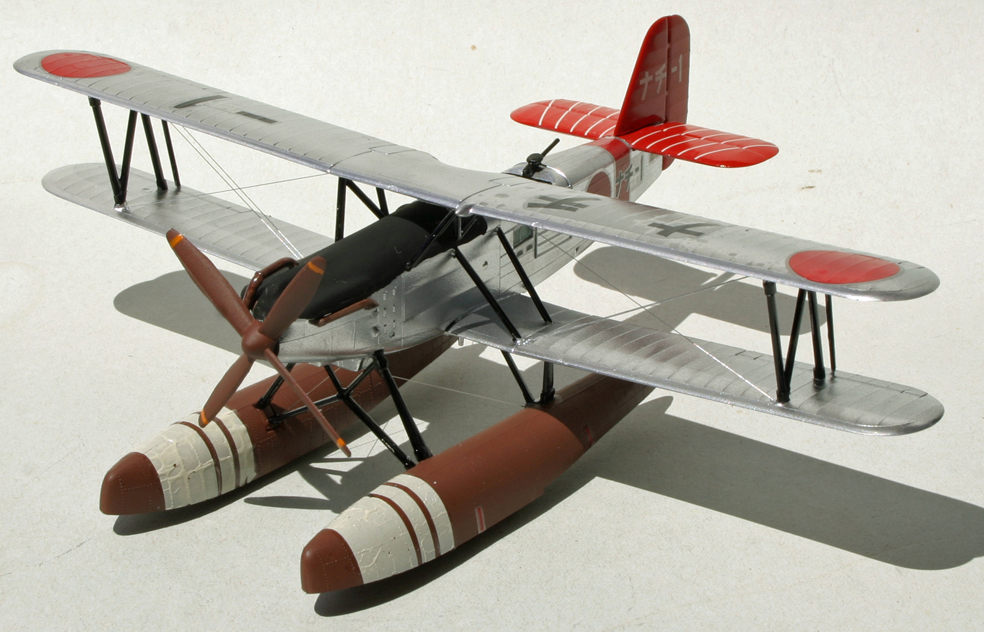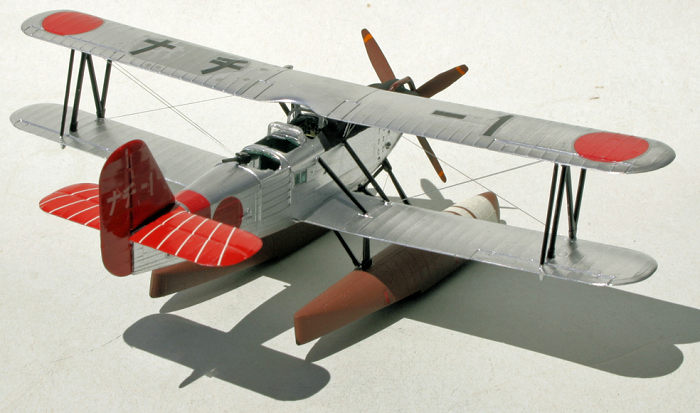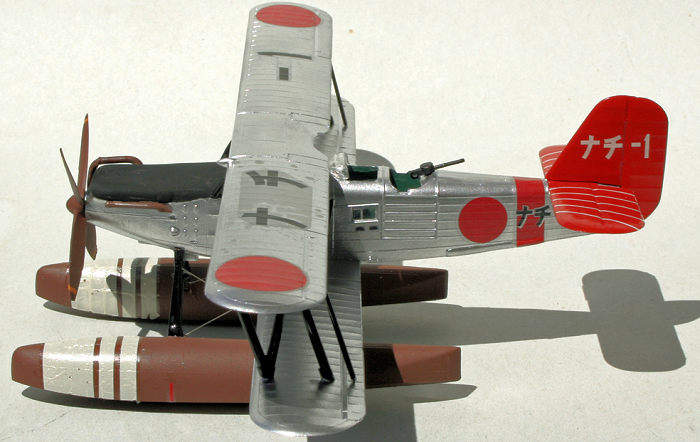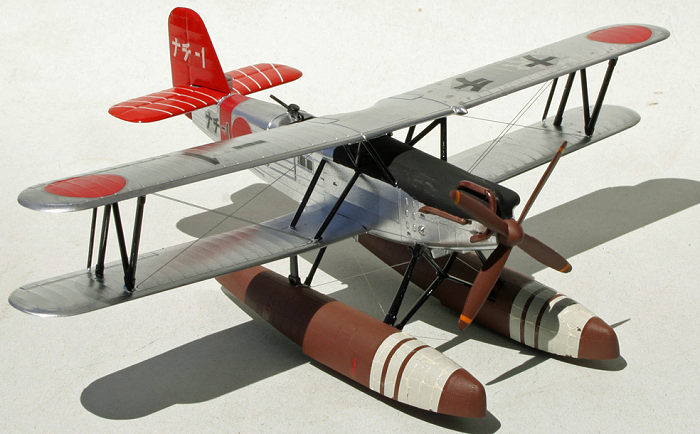
Hasegawa 1/72 E7K1 'Alf'
| KIT #: | NP11 |
| PRICE: | $15.00 |
| DECALS: | Two options |
| REVIEWER: | Peter Burstow |
| NOTES: |

| HISTORY |
 The E7K1
was one of the oldest aircraft designs to see service during the Pacific war,
the first prototype flying on February 6, 1933. It was ordered into production
as the Type 94 Reconnaissance seaplane, entering J.N.A.F. service in 1935.
The E7K1
was one of the oldest aircraft designs to see service during the Pacific war,
the first prototype flying on February 6, 1933. It was ordered into production
as the Type 94 Reconnaissance seaplane, entering J.N.A.F. service in 1935.
Originally powered with a 500 h.p. Hiro type 91 liquid cooled engine, it had excellent characteristics, both on the water and in the air. One was flown non-stop from Yokosuka and Bangkok. Later production models were powered with an up-rated 600 h.p. Engine. 183 E7K1 floatplanes were produced between 1934 and 1938.
The aircraft was supplanted by the E7K2 model which had a Mitsubishi MK2 Zuisei 14 cylinder radial engine of 870 h.p. The E7K1 had been phased out of front line service by the start of the Pacific war, being used for training ans other second line duties.
| THE KIT |
This is an early Hasegawa kit, first released, I think, around 1970. It has fine raised line detailing and has held up well over the years. It has been re-boxed many times and is still available. The Hasegawa E7k1 was previewed here. My model included the Ross Abare designed catapult kit, which is also available with Hasegawa's E13A1 Jake kit.
| CONSTRUCTION |
 Nothing
too startling here, the cockpit comprises three seats, of the comfy chair
variety, and a floor. Three figures are supplied which I didn't use. There are
two side windows, which I also didn't use. The fuselage halves can then be
closed up, trapping the propeller shaft. A couple of steps later in the
instructions, the instrument panel decal is shown, too late for me. The fit was
very good, a light sand being all that was needed.
Nothing
too startling here, the cockpit comprises three seats, of the comfy chair
variety, and a floor. Three figures are supplied which I didn't use. There are
two side windows, which I also didn't use. The fuselage halves can then be
closed up, trapping the propeller shaft. A couple of steps later in the
instructions, the instrument panel decal is shown, too late for me. The fit was
very good, a light sand being all that was needed.
The lower wing, which I had pre-drilled for rigging, exhausts, a radiator and a rear hatch were then installed. The upper wing was then fitted using four moulded “N” struts. The structure was relatively strong and lined up well, often a difficulty with biplanes. The aileron interconnects and what I took to be a fuel pipe, completed the airframe.
I built the floats and their struts as a separate sub-assembly. Adding some weight, in the form of a few .22 bullets in the front of the floats, prevents tail sitting, as much of a problem with seaplanes as it is with tricycles. The tail-plane and fin were left off to save masking.
The simple rigging was added using invisible mending thread mono-filament. With the pre-drilled holes it was quick and easy.
| COLORS & MARKINGS |
I choose the model on board the Nachi, a heavy cruiser. This was overall silver
dope, with red tail surfaces. The fuselage and wings were sprayed with rattle
can aluminium enamel, the floats with Tamiya TS-62 NATO brown, which I also used
on the propeller. The tail surfaces were painted TS-86 red, which is a good
match with the decal stripes and roundels. The tailplane and fin, and the float
assembly was then added before decalling.
 The decals
were then added, with the usual Hasegawa problem of very slow to release from
the backing paper. I used very hot water and had most of the decals soaking at
the same time. The white decals on the floats cracked and started to fall apart,
these markings would have been better sprayed and masked.
The decals
were then added, with the usual Hasegawa problem of very slow to release from
the backing paper. I used very hot water and had most of the decals soaking at
the same time. The white decals on the floats cracked and started to fall apart,
these markings would have been better sprayed and masked.
The float colour is subject to some dispute, the instructions state propeller colour, whatever that is. The box art shows green and grey. An earlier box shows brown, and other boxes show grey. Brown looks OK to me, and I don't really care if it's wrong.
The anti-dazzle panel, struts, exhausts, radiator and other small parts were brush painted with a variety of enamel and acrylic paints.
Not much more to do here, added the two tiny windscreens and used Kristal Klear to make the small side windows. The last part was the machine gun in the rear cockpit. I didn't fit the two small bombs.
| CONCLUSIONS |
An easy and very enjoyable project. Despite the inherent complexity of biplanes, with the added confusion of floats, the kit went together quickly with no problems other than a minor hitch with the decals.
Recommended for anybody, a good first biplane.
| REFERENCES |
William Green, Floatplanes, Warplanes of the Second World War Volume six, Macdonald, London 1962.
Claude Boileau, Encyclopaedia of Military Models, TAB books, 1988
27 April 2018
Copyright ModelingMadness.com
If you would like your product reviewed fairly and fairly quickly, please contact the editor or see other details in the Note to Contributors.
Back to the Main Page Back to the Review Index Page Back to the Previews Index Page